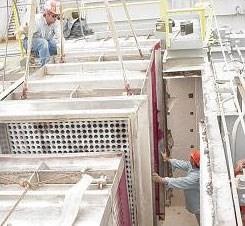 The Challenge
The Challenge
A manufacturer of insulation films for the electronics industry needed to evaluate the capabilities of four existing oxidizers that treated emissions from its coating lines. The company was concerned that, due to oxidizer deficiencies, it would not meet regulatory requirements. The oxidizers had been manufactured by two different companies. One of them was no longer in business and the other was unable to provide an adequate solution. The customer needed an experienced engineering company that could accurately identify the oxidizers’ deficiencies and provide quality repairs.
The Solution
After evaluating the service capabilities of several equipment manufacturers and engineering consultants, the company chose the full-service solution offered by Anguil Environmental Systems. Anguil’s comprehensive preventive maintenance evaluations of the four oxidizers provided detailed recommendations to improve the oxidizers’ performance. The most urgent recommendation saved the company thousands of dollars in operating costs and put the company in compliance.
The Result
Anguil’s rigorous 75-point Preventive Maintenance Evaluation (PME) discovered minor problems with three of the units and a major problem with the largest oxidizer, a 13,500 SCFM (21667.5 Nm3/hr) catalytic oxidizer. Anguil’s recommendations for the three smaller oxidizers greatly improved their safety and performance. Many of the cost-saving suggestions were easily performed by the plant’s in-house maintenance staff. However, the larger oxidizer required more intensive application engineering and a comprehensive air pollution control solution.
Heat Exchanger Study
The 13,500 SCFM (21667.5 Nm3/hr) system had both a primary and secondary heat exchanger. The primary heat exchanger recovers energy from the combustion chamber exhaust and transfers it to the incoming process air stream to reduce fuel consumption. The secondary heat exchanger recovers additional energy from the primary heat exchanger outlet flow and uses this energy to preheat an air source used in the process. In this case, the secondary heat exchanger is integral to the plant’s coating process; it is used to heat the tower dryer of the AISCO coating machine. The plant engineers had noticed a steady decline in the heat available from the oxidizer and secondary heat exchanger. By the time of Anguil’s investigation, the oxidizer took up to six hours to sufficiently heat the coater before production could begin. During the six hours of warm-up, the oxidizer had to be supplied with natural gas. This tremendous fuel consumption led to extremely high operating costs.

Anguil performed a destruction efficiency test on the oxidizer when the coated web used 100% toluene as a solvent. Under normal conditions, an oxidizer of this type should have little difficulty in attaining better than 98% destruction efficiency. Due to the airflow bypassing the combustion chamber, the oxidizer was achieving only 93.6% destruction efficiency and did not meet regulatory emission requirements.
Replacing the oxidizer would have drastically interrupted the customer’s manufacturing schedule and resulted in capital cost increases that were unacceptable. Anguil’s solution, however, eliminated any production disruptions by performing repairs and design enhancements over several process downtimes. The first step was to immediately replace both the primary and secondary heat exchangers. Anguil designed, manufactured and installed replacement exchangers for this oxidizer. The dismantling, removal and replacement of the exchangers were performed over a three-day weekend when the customer had a scheduled plant shutdown.
- Improved Destruction Efficiency
- Annual Cost Savings
- Improved Start-up Time
The replacement heat exchangers significantly improved the performance of the 13,500 SCFM (21667.5 Nm3/hr) oxidizer. Previously, the oxidizer had to be run for up to six hours to meet the necessary temperature at a fuel cost estimate of $266/per startup. The process air temperature required for the coating machine is now achieved in one hour. The improved efficiency results in operating cost savings of approximately $230 per startup and up to $30,000 annually. The economic impact of the retrofitted heat exchangers went beyond fuel savings; the improved start-up time has reduced plant downtime and increased worker production. The new heat exchangers have also improved the destruction efficiency of the oxidation system and put the company in compliance.
Anguil’s analysis detailed other cost saving suggestions for the company, including:
- Ductwork adjustments for more efficient oxidizer operation
- Heat exchanger maintenance suggestions for all four oxidizers
- Review of safety controls and upgrade recommendations
- Variable Frequency Drive for the fan on the largest oxidizer to accommodate airflow changes more efficiently
- Burner maintenance suggestions
Anguil also performed airflow analysis of all processes. This information will help the company plan for future growth with additional coating lines.
The retrofitted system is currently exceeding the regulatory requirements and providing an efficient heat source for the coating lines. The Anguil service team’s expert troubleshooting and quality turnkey solution capabilities have led to another satisfied customer.

